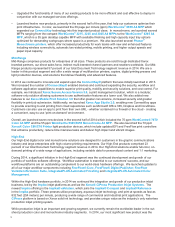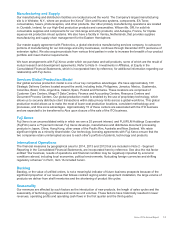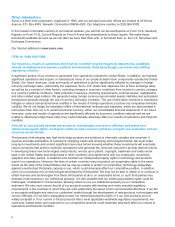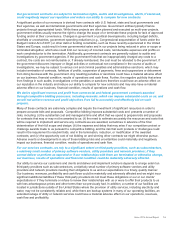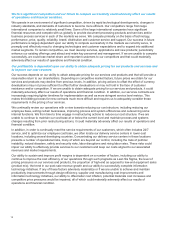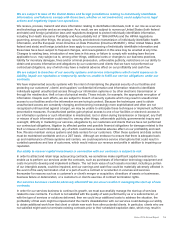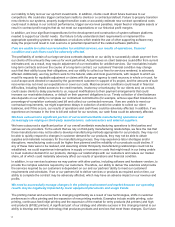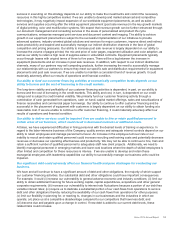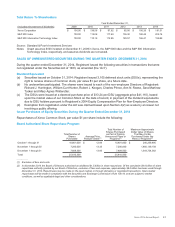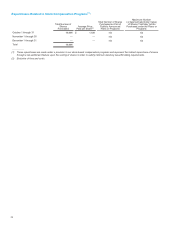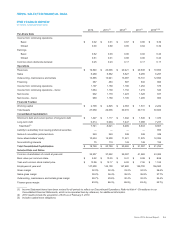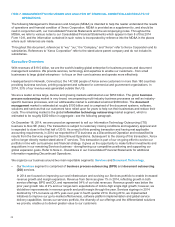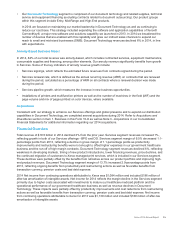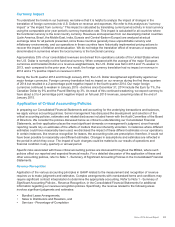Xerox 2014 Annual Report Download - page 34
Download and view the complete annual report
Please find page 34 of the 2014 Xerox annual report below. You can navigate through the pages in the report by either clicking on the pages listed below, or by using the keyword search tool below to find specific information within the annual report.We need to maintain adequate liquidity in order to meet our operating cash flow requirements, repay
maturing debt and meet other financial obligations, such as payment of dividends to the extent declared by
our Board of Directors. If we fail to comply with the covenants contained in our various borrowing
agreements, it may adversely affect our liquidity, results of operations and financial condition.
Our liquidity is a function of our ability to successfully generate cash flows from a combination of efficient operations
and continuing operating improvements, access to capital markets and funding from third parties. We believe our
liquidity (including operating and other cash flows that we expect to generate) will be sufficient to meet operating
requirements as they occur; however, our ability to maintain sufficient liquidity going forward depends on our ability
to generate cash from operations and access to the capital markets and funding from third parties, all of which are
subject to the general liquidity of and on-going changes in the credit markets as well as general economic, financial,
competitive, legislative, regulatory and other market factors that are beyond our control.
The Credit Facility contains financial maintenance covenants, including maximum leverage (debt for borrowed
money divided by consolidated EBITDA, as defined) and a minimum interest coverage ratio (consolidated EBITDA
divided by consolidated interest expense, as defined). At December 31, 2014, we were in full compliance with the
covenants and other provisions of the Credit Facility. Failure to comply with material provisions or covenants in the
Credit Facility could have a material adverse effect on our liquidity, results of operations and financial condition.
Our business, results of operations and financial condition may be negatively impacted by legal and
regulatory matters.
We have various contingent liabilities that are not reflected on our balance sheet, including those arising as a result
of being involved in a variety of claims, lawsuits, investigations and proceedings concerning: securities law;
governmental entity contracting, servicing and procurement laws; intellectual property law; environmental law;
employment law; the Employee Retirement Income Security Act (ERISA); and other laws and regulations, as
discussed in the “Contingencies” note in the Consolidated Financial Statements. Should developments in any of
these matters cause a change in our determination as to an unfavorable outcome and result in the need to
recognize a material accrual or materially increase an existing accrual, or should any of these matters result in a
final adverse judgment or be settled for significant amounts above any existing accruals, it could have a material
adverse effect on our results of operations, cash flows and financial position in the period or periods in which such
change in determination, judgment or settlement occurs.
Our operations and our products are subject to environmental regulations in each of the jurisdictions in which we
conduct our business and sell our products. Some of our manufacturing operations use, and some of our products
contain, substances that are regulated in various jurisdictions. For example, various countries and jurisdictions have
adopted or are expected to adopt restrictions on the types and amounts of chemicals that may be present in
electronic equipment or other items that we use or sell. If we do not comply with applicable rules and regulations in
connection with the use of such substances and the sale of products containing such substances, then we could be
subject to liability and could be prohibited from selling our products in their existing forms, which could have a
material adverse effect on our results of operations and financial condition. Further, various countries and
jurisdictions have adopted or are expected to adopt, programs that make producers of electrical goods, including
computers and printers, responsible for certain labeling, collection, recycling, treatment and disposal of these
recovered products. If we are unable to collect, recycle, treat and dispose of our products in a cost-effective manner
and in accordance with applicable requirements, it could materially adversely affect our results of operations and
financial condition. Other potentially relevant initiatives throughout the world include proposals for more extensive
chemical registration requirements and/or possible bans on the use of certain chemicals, various efforts to limit
energy use in products and other environmentally related programs impacting products and operations, such as
those associated with climate change accords, agreements and regulations. For example, the European Union's
Energy-Related Products Directive (ERP) has led to the adoption of “implementing measures” or "voluntary
agreements" that require certain classes of products to achieve certain design and/or performance standards, in
connection with energy use and potentially other environmental parameters and impacts. A number of our products
are already required to comply with ERP requirements and further regulations are being developed by the EU
authorities. Another example is the European Union “REACH” Regulation (Registration, Evaluation, Authorization
and Restriction of Chemicals), a broad initiative that requires parties throughout the supply chain to register, assess
and disclose information regarding many chemicals in their products. Depending on the types, applications, forms
and uses of chemical substances in various products, REACH could lead to restrictions and/or bans on certain
chemical usage. Xerox continues its efforts toward monitoring and evaluating the applicability of these and
numerous other regulatory initiatives in an effort to develop compliance strategies. As these and similar initiatives
and programs become regulatory requirements throughout the world and/or are adopted as public or private
19


